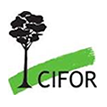NATURAL SOLUTIONS
Blue carbon ecosystems offer multiple services, which include: enhancing productivity of fisheries; improving coastline stability; offering a barricade against erosion and increased sea level; protection against storms; water filtration and biodiversity conservation, but they can also contribute efficiently and effectively to the fight against climate change.
“From the mitigation viewpoint, blue carbon ecosystems are recognized for their high productivity rates and for their great capacity to store carbon in the soil, said Rosa Roman-Cuesta, a scientist with CIFOR. “And from the adaptation viewpoint, they are fundamental for the supply of food and for coastal stability with respect to the rising sea level or the increase of tropical storms,” she added.
Despite these benefits, mangrove degradation is all too common the world over, making it crucial to redouble efforts aimed at preservation, sustainable management and restoration.
Yucatán’s mangroves, have disappeared mainly due to the development of urban, tourist and highway infrastructure. Studies conducted in 2017 have determined that overall Mexico has lost more than 18,000 hectares of mangroves, compromising their social and ecological benefits.
Ciénaga del Progreso, Yucatán, México. Claudia Teutli underscores the importance of an ecosystemic approach for the success of mangrove restoration.
Yoly Gutierrez/CIFOR.
Jorge Herrera explains mangrove restoration activities to journalists of Mesoamerica in Curva de Yucalpetén, 60 minutes drive from Mérida. Five of a total of seven degraded hectares are restored.
Yoly Gutierrez/CIFOR.
FOUR KEYS TO SUCCESSFUL RESTORATION
Claudia Teutli, a postdoctoral researcher in the science department of the National Autonomous University of Mexico (UNAM), has known ever since she was young that she wanted to remain close to the sea for the rest of her life, so after graduating as a marine biologist she focused her career and research on mangrove restoration. With Herrera, she has published numerous scientific studies focused on blue carbon ecosystems and mangrove restoration.
Although the scientists warn that their findings may vary depending on environmental conditions and the initial state of each site slated for restoration, they offer four main best-practice lessons for mangrove recovery.
- Think of mangroves, think of water
“One thing we must not forget when proposing to restore mangroves is that we have to consider two components: reforestation and hydrological conditions,” said Teutli, explaining that often those who implement mangrove restoration actions overlook the fact that these are wetlands.
Sometimes just a little help is enough she said, explaining that reintroducing water to recover the area’s hydrological nature – for example, if a natural channel has been blocked by infrastructure – will favor the appearance of native fauna and vegetation due to natural regeneration. She cited as examples such locations as Ciénaga del Progreso and Curva de Yucalpetén in Merida, where interventions have been successful.
While the first step to restore these sites was to bring back water, they also established a planting strategy that took into account a natural selection criteria by planting 10 — parts of the mangrove that work as seeds – each time, knowing at least one, as in nature, would survive. It worked.
- Restoring isn’t (just) reforesting
“Many mangrove restoration projects use reforestation as a their main approach, in which the plant is started in nurseries, but this brings various challenges,” Teutli said. “For example, the species appropriate for the site isn’t necessarily the one planted but rather the one easiest to replant.”
Another challenge is that often mangrove saplings from nurseries don’t survive when replanted in selected restoration sites. The reason, according to Herrera, can be explained using a parenting lesson: “Those seedlings are like pampered children who don’t know the world. They are overprotected in nurseries, but when taken to natural areas, not all are prepared for the sun, salinity, etc., so they don’t survive, just as they would in nature through natural selection.”
- Eco-systemic approach or failure
An additional issue observed by researchers is that generally speaking many mangrove restoration projects don’t take into account eco-systemic considerations. “Mangrove restoration hasn’t generally focused on an ecosystem perspective, but on a plantation approach without considering the many factors that regulate environmental conditions that influence the success of restoration in the long term,” Herrera said.
In his view, this is the possible reason why many mangrove restoration efforts all around the globe have failed. An obvious but important conclusion from his experience in Yucatan in this regard is the need to concentrate on the health of the ecosystem itself. “If we firstly recover the ecosystem’s health or work to maintain its resilience, replanted mangroves will be able to survive rising sea levels, hurricanes and other events expected to be more frequent with climate change.”
For Herrera and Teutli, taking into account the factors that regulate environmental conditions such as species that facilitate survival of mangroves, salinity indicators and soil sediments changes are crucial to succeed in mangrove restoration.
“Let’s not forget that when we see a mangrove, we need to think of water, soil sediment and vegetation,” stresses Herrera. “Not just seedlings.”
- Note that not everyone can restore
Who does the restoration and how is an important factor, Teutli emphasizes. “Some attempts fail because those trying to do the restoring aren’t restoration professionals. Restoration requires ecological engineering and the consideration of many factors beyond just reforesting,” she added, urging a return to the basics of science.
“Paradoxically, with technology development and all, we are in an era in which required basic ecological information is no longer being generated,” she said.
She points out the need to look at basic, foundational, ecological formulas for restoration sites, from mangroves to land ecosystems.
“There are standard , but we need to plan restoration considering the specific ecology of the sites. General data is not always applicable to a specific ecosystem and this fact is often overlooked.”


















